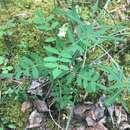Comprehensive Description
provided by North American Flora
Phaca americana (Hook.) Rydb.; Britt. & Brown, 111. Fl. 2: 304 1897.
Phaca frigida Richards, in Frankl. Journey 756. 1823. Not P. frigida L. 1753. Phaca frigida americana Hook. Fl. Bor. Am. 1: 140. 1831. Astragalus frigidus A. Gray, Proc. Am. Acad. 6: 219, in part. 1864. Astragalus frigidus americanus S. Wats. Bibl. Ind. 193. 1878. Astragalus alpinus americanus Sheldon, Minn. Bot. Stud. 1: 133. 1894. Astragalus americanus M. E. Jones, Contr. W. Bot. 8: 8. 1898.
Perennial, with a short branched woody caudex or rootstock; stems several, glabrous or sparingly pilose, striate, straw-colored, 51 2 dm. high ; lower leaves reduced to the mere stipules, the rest 1-1.5 dm. long, ascending; stipules membranous, free, reflexed, yellowish-green, oblong, 1-2 cm. long; petioles 1-3 cm. long, as well as the rachis striate or nearly glabrous; leaflets 9-13, oblong, thin, acute at the base, mostly rounded at the apex, 2-6 cm. long, 0.7-2 cm. wide, thin, glabrous above, sparingly pubescent beneath; peduncles 5-10 cm. long; racemes 2-4 cm. long; bracts oblong, ciliate, 5 mm. long, reflexed, deciduous; calyx oblong-campanulate, about 5 mm. long, somewhat oblique, yellowish, glabrous except the ciliolate margin, the lobes very short, broadly triangular, rather broader than long; corolla ochroleucous, about 15 mm. long; banner obovate, retuse at the apex, moderately arched, with reflexed margins, gradually tapering below; wings 12 mm. long, the blade oblong-lunate, obtuse, shorter than the long claw, with an acute basal auricle; keel-petals similar, but broader, rounded at the apex, and with an obtuse auricle; pod glabrous, very thin, yellowish, unspotted, the stipe 7-10 mm. long, the body ellipsoid, acute at each end, 2-2.5 cm. long, 8-10 mm. wide and thick; seeds dark olivebrown, obliquely round-ovate, 3 mm. long, 2 mm. wide, the scar near the middle of one side.
Type locality: Rocky Mountains, in lat. 52° to 56°.
Distribution: Wooded banks in the Rocky Mountains from Yukon to Wyoming, in the Black Hills, South Dakota, and on Gasp£ Peninsula, Quebec.
- bibliographic citation
- Per Axel Rydberg. 1919. (ROSALES); FABACEAE; PSORALEAE. North American flora. vol 24(1). New York Botanical Garden, New York, NY
Physical Description
provided by USDA PLANTS text
Perennial, Herbs, Stems woody below, or from woody crown or caudex, Plants with rhizomes or suckers, Taproot present, Nodules present, Stems erect or ascending, Stems less than 1 m tall, Stems solid, Stems or young twigs glabrous or sparsely glabrate, Stems or young twigs sparsely to densely hairy, Stem hairs hispid to v illous, Leaves alternate, Leaves petiolate, Stipules conspicuous, Stipules membranous or chartaceous, Stipules persistent, Stipules free, Stipules connate to each other, forming a tuber or sheath, Leaves compound, Leaves odd pinnate, Leaf or leaflet margins entire, Leaflets opposite, Leaflets 10-many, Leaves hairy on one or both surfaces, Inflorescences racemes, Inflorescence axillary, Bracts very small, absent or caducous, Flowers zygomorphic, Calyx 5-lobed, Calyx glabrous, Petals separate, Corolla papilionaceous, Petals clawed, Petals white, Petals ochroleucous, cream colored, Banner petal narrow or oblanceolate, Wing petals narrow, oblanceolate to oblong, Wing tips obtuse or rounded, Keel petals auriculate, spurred, or gibbous, Keel tips obtuse or rounded, not beaked, Stamens 9-10, Stamens diadelphous, 9 united, 1 free, Filaments glabrous, Style terete, Style persistent in fruit, Fruit a legume, Fruit stipitate, Fruit unilocular, Fruit freely dehiscent, Fruit oblong or el lipsoidal, Fruit or valves persistent on stem, Fruit exserted from calyx, Fruit inflated or turgid, Fruit beaked, Fruit glabrous or glabrate, Fruit hairy, Fruit 11-many seeded, Seeds cordiform, mit-shaped, notched at one end, Seed surface smooth, Seeds olive, brown, or black.

